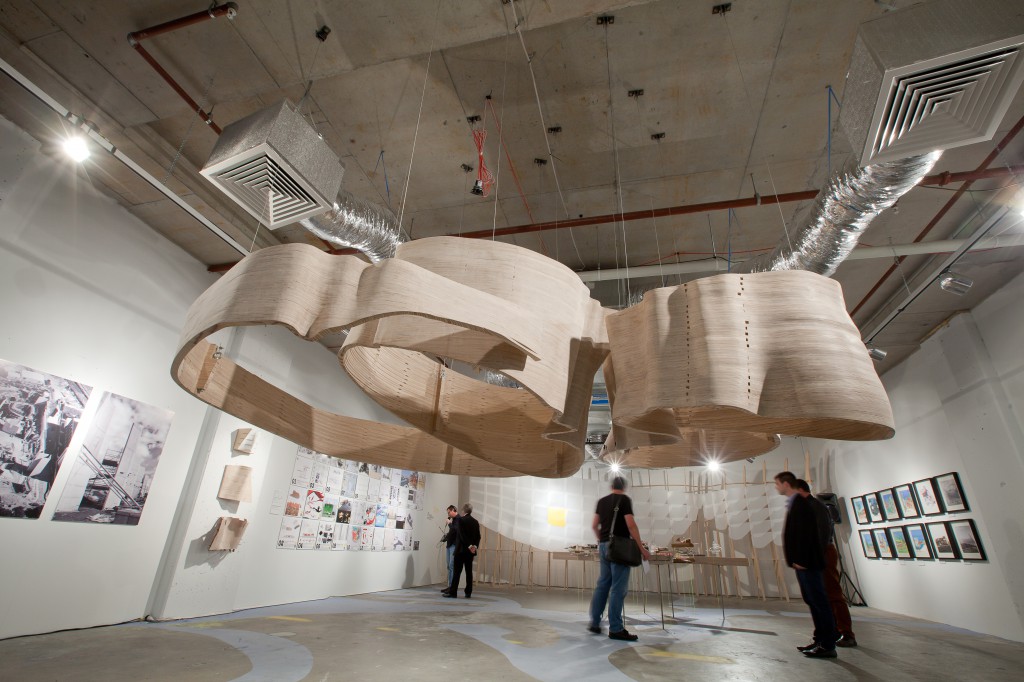Bond University.
ART’s XR Router installed at Queensland’s Bond University helps students to bring their projects to life.
Gold Coast-based Bond University’s School of Architecture’s vision is unique but simple: It aims to combine teaching excellence with practical experience to deliver top-class graduates. Practical hands-on projects contribute to a large part of the Bachelor of Architectural Studies, where students learn about shape and form, textile usage, light and shade influences, structure and strength, design aesthetics and a host of other architectural influences that exist in this creatively driven profession.

“The WRAP” exhibited at the exhibition of speculative proposals for the Gold Coast cultural precinct, processed on the ART router.
In early 2012 the school decided it was time to add a state-of-the art CNC router from Brisbane-based Advanced Robotic Technology (ART) to its technical equipment, which already included a CNC laser cutter and 3D printer.
Jonathan Nelson, Teaching Fellow and the manager of the Digital Fabrication and Research Laboratory at the Solheil Abedian School of Architecture, was looking for something to process large materials and to do more sculpting tech work when he came across ART’s range of CNC routers. He has spent the last ten years working in the architecture, fabrication, and software development fields, and knew exactly what he was looking for.
“The machine had to be well-made, it had to be high-durability, high-capacity, and we needed someone as local as possible to service the machine,” he says. “ART have absolutely provided that service. While it might be cheaper to buy an imported machine from Asia, it is hard to get the service. With ART we are dealing with a local company that can provide something that’s worth the extra price!”
The Lab’s XR3500 CNC Router is unique in the Australian marketplace, as the only 100% Australian-made machine designed for various applications featuring an additional fourth axis for automatic tool changes including special tools such as knives for foam cutting. The gantry-mounted covered tool-changer turns variable-angle cutting, creasing and routing needed to create architectural 3D shapes into one efficient fully automated process.
According to Mr Nelson, studio assignments have been purposefully designed to introduce the students to the intellectual, material and spatial culture of architecture; seeing, understanding and responding o the parameters of place; recognising landscape as architecture … all intended to foster design and strategic thinking skills and the value of risk taking in the creative process.
The Fabrication and Research Laboratory now provides all the tools to fabricate both small scale models or full-size prototypes and sculptures. Wood, plastic, MDF, dense foam and soon aluminium are among the many types of materials that can be machined or manipulated in the shop. Students create sculptures and other architectural artwork, and use the CNC router as a major tool in their shop. The photos illustrate just a few examples of some of the exciting work being created.
“The Fabrication Lab provides a setting in which students learn basics of fabrication and CNC programming,” Mr Nelson says. “The students don’t exactly learn how to do the CAM programming, they sit with me and learn what the strengths and weaknesses of the CNC router are and what it can and can’t do.”
Mr Nelson adds that he uses the router in as many of his classes as possible and student frequently use it for studio projects, which have been purposefully designed to introduce the students to the intellectual, material and spatial culture of architecture.
Much of the artwork processed on the ART router was recently on display at the Speculator gallery exhibition, a design studio and public event guided by Gavin Robotham and Mark Bagguley of CRAB studio London. Here, the students and staff have experienced the exhilaration and exhaustion of designing, building, promoting and putting up for public scrutiny an exhibition of ideas.
The photo shows the “WRAP” that was processed on the SMART router and exhibited at the exhibition of speculative proposals for the Gold Coast cultural precinct, aimed to ignite our aspirations for a meaningful and valued civic place to transform the cultural heartland of the Gold Coast.
Since the router has been installed, most of the other machines like bandsaws are now collecting dust. Innovation has a tendency to do that.
“The router takes a lot of the work over we formerly used to do with the other equipment,” he says. “Having that machine around has taken the need from me to train students on smaller woodworking equipment. I don’t train students on the band-saw anymore because the router does all the work. It is also easier for the students now because they have already drawn everything on the computer, and get a lot more done with the router today.”
While Mr Nelson admits that the CAD/CAM software the school is using is a bit hard to get used to, the machine is really simple. “Once all the drawings are converted to the G-Code, the machine cuts all parts precisely and fast. It is an excellent machine. We have put it through a lot of work and it runs pretty much constantly towards the end of the semester.”
“We would absolutely go with one of ART’s machines again – it is the service and the quality of the machine itself. It is worth the extra money!”